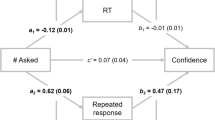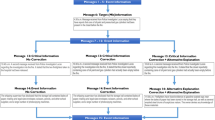Abstract
Two experiments tested the proposition that postevent questioning can lead to later increases in witness confidence without corresponding changes in witness accuracy. After a staged interruption in a college classroom, participants were questioned about the event 5 times over 5 weeks in Experiment 1 (n=57) and 3 times over 5 days in Experiment 2 (n=79). During the final questioning session, the participant-witnesses consistently reported higher levels of confidence for those items that had been subject to repeated postevent questioning than for those items that were asked for the first time, yet there was no difference in the accuracy of the responses to the two sets of items. Additionally, in all conditions the participant-witnesses were generally overconfident in their responses. These results suggest that repeated postevent questioning can cause eyewitnesses' subsequent confidence estimates to be “artificially” inflated.
Similar content being viewed by others
References
Anderson, M. C., Bjork, R. A., & Bjork, E. L. (1994). Remembering can cause forgetting: Retrieval dynamics in long-term memory.Journal of Experimental Psychology: Learning, Memory, and Cognition, 20, 1063–1087.
Backman, C. W. (1988). The self: A dialectical approach. In: L. Berkowitz (Ed.),Advances in experimental social psychology, (Vol. 21, pp. 229–260). New York: Academic.
Bekerian, D. A. (1993). In search of the typical eyewitness.American Psychologist, 48, 574–576.
Bjork, R. A. (1975). Retrieval as a memory modifier: An interpretation of negative recency and related phenomena. In R. L. Solso (Ed.),Information processing and cognition: The Loyola symposium (pp. 123–144). Hillsdale, NJ.: Erlbaum.
Bjork, R. A. (1988). Retrieval practice and the maintenance of knowledge. In M. M. Gruneberg, P. E. Morris & R. N. Sykes (Eds.),Practical aspects of memory II (pp. 396–401). London: Wiley.
Bjork, R. A. & Bjork, E. L. (1992). A new theory of disuse and an old theory of stimulus fluctuation. In A. F. Healy, S. M. Kosslyn, & R. M. Shiffrin (Eds.),From learning processes to cognitive processes Essays in honor of William K. Estes (Vol. 2, pp. 35–67). Hillsdale NJ: Erbaum.
Bothwell, R. K., Deffenbacher, K. A., & Brigham, J. C. (1987). Correlation of eyewitness accuracy and confidence: Optimality hypothesis revisited.Journal of Applied Psychology, 72, 691–695.
Brigham, J. C. & Bothwell R. K. (1983). The ability of prospective jurors to estimate the accuracy of eyewitness identifications.Law and Human Behavior, 7, 19–30.
Brigham, J. C., & Wolfskeil, M. P. (1983). Opinions of attorneys and law enforcement personnel on the accuracy of eyewitness identification.Law and Human Behavior, 7, 337–349.
Cutler, B. L., & Penrod S. D. (1995)Mistaken identification: The eyewitness, psychology, and the law. New York: Cambridge University Press.
Cutler, B. L., Penrod, S. D., & Dexter, H. R. (1990). Juror sensitivity to eyewitness identification evidence.Law and Human Behavior, 14, 185–191.
Cutler, B. L., Penrod, S. D., & Stuve, T. E. (1988). Juror decision making in eyewitness identification cases.Law and Human Behavior, 12, 41–55.
Deffenbacher, K. A. (1980). Eyewitness accuracy and confidence: Can we infer anything about their relationship?Law and Human Behavior, 4, 243–260.
Deffenbacher, K. A. (1991). A maturing of research on the behaviour of eyewitnesses.Applied Cognitive Psychology, 5, 377–402.
Deffenbacher, K. A., & Loftus, E. F. (1982). Do jurors share a common understanding concerning eyewitness behavior?Law and Human Behavior, 6, 15–30.
Dunning, D., Griffin, D. W., Milojkovic, J. D., & Ross, L. (1990). The overconfidence effect in social prediction.Journal of Personality and Social Psychology, 58, 568–581.
Fischhoff, B., Slovic, P. & Lichtenstein, S. (1977). Knowing with certainty: The appropriateness of extreme confidence.Journal of Experimental Psychology: Human Perception and Performance, 3, 552–564.
Fisher, R. P., Geiselman, R. E., & Amador, M. (1989). Field test of the cognitive interview: Enhancing the recollection of actual victims and witnesses of crime.Journal of Applied Psychology, 74, 722–727.
Fiske, S. T., & Taylor, S. E. (1991).Social cognition. New York: McGraw-Hill.
Geiselman, R. E., Fisher, R. P., MacKinnon, D. P., & Holland, H. L. (1985). Eyewitness memory enhancement in the police interview: Cognitive retrieval mnemonics versus hypnosis.Journal of Applied Psychology, 70, 401–412.
Koriat, A., Lichtenstein, S., & Fischhoff, B. (1980). Reasons for confidence.Journal of Experimental Psychology: Human Learning and Memory, 6, 107–118.
Landauer, T. K., & Bjork, R. A. (1978). Optimal rehearsal patterns and name learning. In M. M. Gruneberg P. E. Morris, & R. N. Sykes (Eds.),Practical aspects of memory (pp. 625–632). London: Academic.
Leippe, M. R. (1980). Effects of integrative memorial cognitive processes on the correspondence of eyewitness accuracy and confidence.Law and Human Behavior, 4, 261–274.
Lichtenstein, S., & Fischhoff, B. (1977). Do those who know more also know more about how much they know? The calibration of probability judgments.Organizational Behavior and Human Performance, 20, 159–183.
Lichtenstein, S., & Fischhoff, B. (1980). Training for calibration.Organizational Behavior and Human Performance, 26, 149–171.
Lichtenstein, S., Fischhoff, B., & Phillips, L. D. (1982). Calibration of probabilities: The state of the art to 1980. In D. Kahneman, P. Slovic, & A. Tversky (Eds.),Judgment under uncertainty: Heuristics and biases (pp. 306–334). Cambridge: Cambridge University Press.
Loftus, E. F. (1974). Reconstructing memory: The incredible witness.Psychology Today, 8, 116–119.
Loftus, E. F. (1975). Leading questions and the eyewitness report.Cognitive Psychology, 7, 560–572.
Loftus, E. F. (1979).Eyewitness testimony. Cambridge, MA: Harvard University Press.
Loftus, E. F., Miller, D. G., & Burns, H. J. (1978). Semantic integration of verbal information into a visual memory.Journal of Experimental Psychology: Human Learning and Memory, 4, 19–31.
Loftus, E. F., & Palmer, J. P. (1974). Reconstruction of automobile destruction: An example of the interaction between language and memory.Journal of Verbal Learning and Verbal Behavior, 13, 585–589.
Luus, C. A. E., & Wells, G. L. (1994a). Eyewitness identification confidence. In: D. F. Ross, J. D. Read, & M. P. Toglia (Eds.),Adult eyewitness testimony (pp. 348–361). New York: Cambridge University Press.
Luus, C. A. E., & Wells, G. L. (1994b). The malleability of eyewitness confidence: Co-witness and perseverance effects.Journal of Applied Psychology, 79, 714–723.
Malpass, R. S. & Devine, P. G. (1981) Guided memory in eyewitness identification Jounal of Applied Psychology,66, 343–350.
Mandler, G. (1979). Organization and repetition: An extension of organizational principles with special reference to rote learning. In L. G. Nilsson (Ed.),Perspectives on memory research (pp. 293–327). Hillsdale, NJ: Erlbaum.
Mandler, G. (1980). Recognizing: The judgment of previous occurrence.Psychological Review, 98, 252–271.
Manson v. Braithwaite, 432 U.S. 98, 112, 97 S.Ct. 2243, 2252, 53 L.Ed.2d 140 (1977).
Neil v. Biggers, 409 U.S. 188, 34 L.Ed.2d 401 (1972),cert. denied 444 U.S. 909, 100 S.Ct. 221, 62 L.Ed. 2d 144 (1979).
Noon, E., & Hollin, C. R. (1987). Lay knowledge of eyewitness behaviour: A British survey.Applied Cognitive Psychology, 1, 143–153.
Paese, P. W., & Feuer, M. A. (1991). Decisions, actions, and the appropriateness of confidence in knowledge.Journal of Behavioral Decision Making, 4, 1–16.
Paese, P. W., & Kinnaly, M. (1991). Effects of role assignment and verbal interaction on accuracy and overconfidence in interpersonal judgment.Journal of Applied Social Psychology 21, 1418–1439.
Paese, P. W., & Sniezek, J. A. (1991). Influences on the appropriateness of confidence in judgment: Practice, effort, information, and decision making.Organizational Behavior and Human Decision Processes 48, 100–130.
Shaw, J. S., III (1996). Increases in eyewitness confidence resulting from postevent questioning.Journal of Experimental Psychology: Applied, 2, 126–146.
Shaw, J. S., III, Bjork, R. A., & Handal, A. (1995). Retrieval-induced forgetting in an eyewitness-memory paradigm.Psychonomic Bulletin & Review, 2, 249–253.
Sporer, S. L., Penrod, S., Read, D., & Cutler, B. (1995). Choosing, confidence, and accuracy: A meta-analysis of the confidence-accuracy relationship in eyewitness identification studies.Psychological Bulletin, 118, 315–327.
Swann, W. B., Jr., (1983). Self-verification: Bringing social reality into harmony with the self. In J. Suls & A. G. Greenwald (Eds.),Psychological perspectives on the self (Vol. 2, pp. 33–66). Hillsdale, NJ: Erlbaum.
Tulving, E., & Wiseman, S. (1975). Relation between recognition and recognition failure of recallable words.Bulletin of the Psychonomic Society.6, 79–82.
Vallone, R. P., Griffin, D. W., Lin, S. & Ross, L. (1990). Overconfident prediction of future actions and outcomes by self and others.Journal of Personality and Social Psychology, 58, 582–592.
Wells, G. L. (1978). Applied eyewitness testimony research: System variables and estimator variables.Journal of Personality and Social Psychology, 36, 1546–1557.
Wells, G. L. (1993). What do we know about eyewitness identification?American Psychologist, 48, 553–571.
Wells, G. L., Ferguson, T. J., & Lindsay, R. C. L. (1981). The tractability of eyewitness confidence and its implications for triers of factJournal of Applied Psychology, 66, 688–696.
Wells, G. L., Lindsay, R. C. L., & Ferguson, T. J. (1979). Accuracy, confidence, and juror perceptions in eyewitness identification.Journal of Applied Psychology, 64, 440–448.
Wells, G. L., & Murray, D. M. (1983). What can psychology say about the Neil v. Biggers criteria for judging eyewitness accuracy?Journal of Applied Psychology, 68, 347–362.
Wells, G. L. & Murray, D. M. (1984). Eyewitness confidence. In G. L. Wells & E. F. Loftus (Eds.),Eyewitness testimony: Psychological perspectives (pp. 155–170). New York: Cambridge University Press.
Wells, G. L., Seelau, E. P., Rydell, S. M., & Luus, C. A. E. (1994). Recommendations for properly conducted lineup identification tasks. In D. F. Ross, J. D. Read & M. P. Toglia (Eds.),Adult eyewitness testimony: Current trends and developments (pp. 223–241). New York: Cambridge University Press.
Wiseman, S., & Tulving, E. (1976). Encoding specificity: Relation between recall superiority and recognition failure.Journal of Experimental Psychology: Human Learning and Memory, 2, 349–361.
Yarmey, A. D., & Jones, H. P. T. (1983). Is the psychology of eyewitness identification a matter of common sense? In S. Lloyd-Bostock & B. R. Clifford (Eds.),Evaluating witness evidence: Recent psychological research and new perspectives (pp. 13–40). Chichester, England: Wiley.
Yuille, J. C. (1993). We must study forensic eyewitnesses to know about them.American Psychologist, 48, 572–573.
Yuille, J. C. & Wells, G. (1991). Concerns about the application of research findings: The issue of ecological validity. In J. L. Doris, (Ed.),The suggestibility of children's recollections (pp. 118–128). Washington, DC: American Psychological Association.
Author information
Authors and Affiliations
About this article
Cite this article
Shaw, J.S., McClure, K.A. Repeated postevent questioning can lead to elevated levels of eyewitness confidence. Law Hum Behav 20, 629–653 (1996). https://doi.org/10.1007/BF01499235
Issue Date:
DOI: https://doi.org/10.1007/BF01499235




